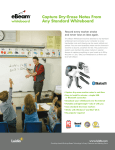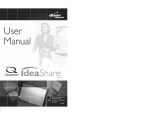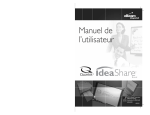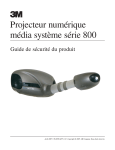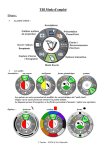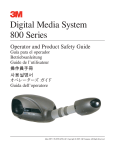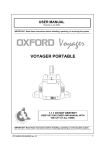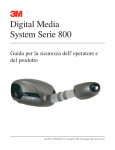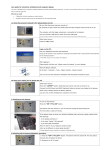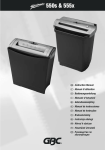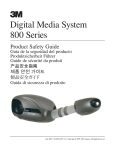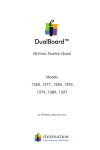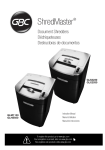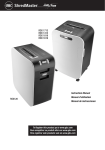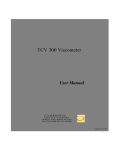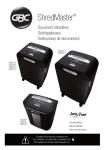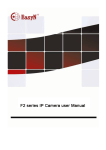Download Quartet® Portable IdeaShare™ user manual - Quartet
Transcript
Thank you for purchasing this exciting new product from Quartet! The Quick Set Up Guide explains how to install your new system quickly and easily. This Users Manual will show you how to save time and money by capturing notes and diagrams, collaborating with colleagues, and enhancing presentations. Please see the Software Reference Guide for quick explanations of how to use the various features made possible by eBeam Software. FCC Class B Notice This device complies with Part 15 of the FCC Rules. Operation is subject to the following two conditions: 1. This device may not cause harmful interference. 2. This device must accept any interference received, including interference that may cause undesired operation. Note: This equipment has been tested and found to comply with the limits for a Class B digital device, pursuant to Part 15 of the FCC Rules. These limits are designed to provide reasonable protection against harmful interference in a residential installation. This equipment generates, uses and can radiate radio frequency energy and, if not installed and used in accordance with the instructions, may cause harmful interference to radio communications. However, there is no guarantee that interference will not occur in a particular installation. If this equipment does cause harmful interference to radio or television reception, which can be determined by turning the equipment off and on, the user is encouraged to try to correct the interference by one or more of the following measures: * Reorient or relocate the receiving antenna. * Increase the separation between the equipment and receiver. * Connect the equipment into an outlet on a circuit different from that to which the receiver is connected. * Consult the dealer or an experienced radio/television technician for help. Foil Shielded Cables: Connections between the IdeaShareTM board and computer and other devices must be made using foil shielded cables in order to maintain compliance with FCC radio frequency emission limits. Modifications: Any modifications made to this device that are not approved by General Binding Corporation may void the authority granted to the user by the FCC to operate this equipment. Canada Class B Notice - Avis Canada, Classe B This Class B digital apparatus complies with Canadian ICES-3. Cet appareil numérique de la classe B est conforme à la norme NMB-003 du Canada. Chapter 1 ........................................................................................................... 1 Quartet® Portable IdeaShare® ......................................................................................................................................1 Software Features ........................................................................................ 1 Chapter 2 ......................................................................................................... 3 Using Quartet Portable IdeaShare ...................................................................... 3 Installing Quartet Portable IdeaShare ............................................................. 3 Using Quartet Portable IdeaShare as a Digital Whiteboard ................................ 4 Using Quartet Portable IdeaShare as a Virtual Touchscreen ............................... 5 Using Quartet Portable IdeaShare with a Flipchart ............................................ 7 Chapter 3 ....................................................................................................... 11 Using eBeam Software with Quartet Portable IdeaShare ..................................... 11 Terminology .............................................................................................. 11 Software Installation & First Time Use .......................................................... 12 Whiteboard Mode ....................................................................................... 14 Calibrate Whiteboard Mode ......................................................................... 14 Using The Whiteboard Mode Application ........................................................ 15 Toolbar ..................................................................................................... 16 Annotation Tools ........................................................................................ 16 Play Controls ............................................................................................. 17 Projection/Virtual Touchscreen Mode ............................................................ 18 Projection Mode Setup ................................................................................ 18 Shortcut Strip - Calibrate & Use ................................................................... 19 The Whiteboard Mode Shortcut Strip ............................................................ 20 The Flipchart Mode Shortcut Strip ................................................................ 21 The eBeam Software Help System ............................................................... 22 Chapter 4 ....................................................................................................... 23 Troubleshooting ............................................................................................ 23 Troubleshooting Tips .................................................................................. 23 Website Support ........................................................................................ 24 Additional Technical Support ....................................................................... 24 Chapter 1 Quartet® Portable IdeaShare® The Quartet Portable IdeaShare system uses eBeam® electronic imaging technology to capture notes and images from any standard whiteboard, easel, or even flipchart pads. Using the Quartet Portable IdeaShare, whatever you draw on a whiteboard or easel is captured electronically in color and in real time and can be saved to a PC, Mac, the Internet or local Intranet. Using the software, you can also share sessions with remote participants live over the Internet/Intranet and create interactive presentations with the virtual touchscreen capability. Software Features Additional popular software features: • Share whiteboard drawings in real time over the Intranet/Internet in an eBeam meeting. Microsoft NetMeeting can also be used to share meetings. • Replay, edit, and annotate images from your meetings and attach them to email messages. Chapter 1 Page 1 • Import images, files, or even a snapshot of your own computer screen into the background of the current meeting for all users to see and annotate. • Use eBeam Software with a projector to turn your whiteboard into a virtual touchscreen. • A "wake up" or Autolaunch feature automatically wakes up the eBeam Software and begins to record once an electronic pen touches the whiteboard. • eBeam Software automatically checks for software updates to make sure you always have the latest features. The Software Reference Guide is included for quick, easy-to-understand instructions on how to use the main software features. This guide is very handy when your Quartet Portable IdeaShare is shared by many users. Simply leave the guide next to the product so everyone can be comfortable with the software and begin taking advantage of this collaboration tool! For more detailed instructions on how to use all of the many software features, refer to the Help menu in the software. Page 2 Quartet Portable IdeaShare Chapter 2 Using Quartet Portable IdeaShare The Quartet Portable IdeaShare system is shown in the image below... Figure A Installing Quartet Portable IdeaShare There are various ways to install your Quartet Portable IdeaShare system. See the Quick Set Up Guide for the standard whiteboard installation (with a suction cup mounting bracket). If you intend to only use your Quartet Portable IdeaShare on one whiteboard, you may choose to permanently attach the mounting bracket using the supplied adhesive strips (the mounting bracket has two flat ledges to accommodate the adhesive strips). For a more permanent attachment, the mounting bracket has three holes for #6 and #8 screws (not included). Even if you permanently install the mounting bracket, you will still be able to remove the Quartet Portable IdeaShare receiver. For flipchart use, please see “Using Quartet Portable IdeaShare with a Flipchart” on page 7 for instructions on how to mount the Quartet Portable IdeaShare onto a flipchart with the flipchart clip. Chapter 2 Page 3 The following sections describe the three different ways to use the Quartet Portable IdeaShare system: • As a digital whiteboard (page 4). • As a virtual touchscreen (page 5). • With a flipchart (PC Only) (page 7). Using Quartet Portable IdeaShare as a Digital Whiteboard Refer to “Terminology” on page 11 for the definition of various terms used in this section. In whiteboard mode, the Quartet Portable IdeaShare receiver is connected to a computer using eBeam Software. Notes and images that you draw on a whiteboard are captured electronically in real time and available for storage and display both locally and remotely through your local Intranet or the Internet. See “Error! Reference source not found.” on page 11 for more information about using the software. To use the Quartet Portable IdeaShare as a digital whiteboard: 1. Set up the electronic pens, the electronic eraser, and the software as shown on the Quick Set Up Guide, and make sure that the receiver is connected to your computer using the USB cable. 2. Set up the Shortcut Strip on the whiteboard by peeling away the backing and placing the strip along an edge of the Image Area. The Shortcut Strip is best positioned along the bottom or side edge to avoid taking up writing space on the whiteboard. 3. Launch eBeam Software on your computer, and make sure that you are in whiteboard mode. You must calibrate the Quartet Portable IdeaShare to the whiteboard, and also calibrate the Shortcut Strip. See “Software Installation & First Time Use” on page 12. To make sure you are in whiteboard mode: 4. • PC: Open the eBeam task bar menu and select “Capture from Whiteboard” • Macintosh OS 9.X: Open the eBeam control panel from the control strip menu and select “Whiteboard mode”. • Macintosh OS 10: Open the eBeam System Settings dialog from the eBeam docklet icon. Select “Whiteboard mode”. Begin writing on the whiteboard using the electronic pens and electronic eraser. Notes and images drawn using the electronic pens and eraser are stored in your computer. See “Error! Reference source not found.” on page 11 for more information about using the software. Page 4 Using Quartet Portable IdeaShare Using Quartet Portable IdeaShare as a Virtual Touchscreen Refer to “Terminology” on page 11 for the definition of various terms used in this section. In virtual touchscreen mode, Quartet Portable IdeaShare allows you to use your whiteboard as your computer desktop. Both the Quartet Portable IdeaShare receiver and the projector connect to your computer. The projector displays your computer desktop onto the whiteboard and the Quartet Portable IdeaShare receiver detects when you touch the board, allowing an electronic pen (using the plastic stylus insert) to act as a virtual mouse used to control your computer’s desktop. In virtual touchscreen mode, you can operate your computer directly from the whiteboard. You can open, work in, and close applications, draw freehand in painting and drawing applications, or you can operate the eBeam meeting application directly from the whiteboard. Virtual touchscreen mode setup is illustrated below. Figure B To use the Quartet Portable IdeaShare in virtual touchscreen mode: 1. Set up a single electronic pen with the plastic stylus insert. The plastic stylus insert looks just like a dry-erase marker except it is entirely plastic and contains no ink. Chapter 2 Page 5 2. Connect the USB cable to the Quartet Portable IdeaShare receiver and your computer, and set up the software as shown on the Quick Set Up Guide. 3. Attach the projector to your computer, and make sure that both the projector and your computer are turned on. 4. Aim and focus the projector as near the center of the whiteboard as possible. 5. Launch eBeam Software on your computer, and make sure that you are in projection mode. You will also need to calibrate. See “Projection/Virtual Touchscreen Mode” on page 18. To make sure that you are in projection mode: 6. • PC: Open the eBeam task bar menu and select “Use With Projector” • Macintosh OS 9.X: Open the eBeam control panel from the control strip menu and select “Projection mode”. • Macintosh OS 10: Open the eBeam System Settings dialog from the eBeam docklet icon. Select “Projection mode”. Begin using the Quartet Portable IdeaShare and whitebaord as a virtual touchscreen. Click or double-click applications to open them, move files, draw in paint programs, or share a meeting using the eBeam meeting software. Anything that you can do with the mouse attached to your computer, you can do with Quartet Portable IdeaShare using the electronic pen and stylus. Page 6 Using Quartet Portable IdeaShare Using Quartet Portable IdeaShare with a Flipchart Refer to “Terminology” on page 11 for the definition of various terms used in this section. Important: To use Quartet Portable IdeaShare with a flipchart chart you must run eBeam Software on a PC. The Mac version of eBeam Software is not compatible with Flipchart mode. Quartet Portable IdeaShare with flipchart clip can be used with two standard flipchart sizes (27” x 34” and 25” x 30.5”), or a custom size that the user specifies. The flipchart clip (shown below) is included in the box. The flipchart clip (Figure C) has a raised portion that is used to mount the Quartet Portable IdeaShare receiver, and an embedded Shortcut Strip. Figure C To set up Quartet Portable IdeaShare with a flipchart: 1. Set up the electronic pens and the software as shown on the Quick Set Up Guide, and make sure that the receiver is attached to your computer using the USB cable. 2. The Quartet Portable IdeaShare receiver attaches to the flipchart clip in the same way that it would attach to a mounting bracket (Figure D). Notice that there are small hooks on the back of the receiver. These hooks fit into slots located at the top left raised portion of the flipchart clip. Fit the receiver hooks into the flipchart clip slots, and then press the receiver down until you either hear a click or feel the receiver snap into place on the flipchart clip. Chapter 2 Page 7 Figure D 3. Attach the flipchart clip to the cardboard flipchart pad backing. The flipchart clip is designed to attach on the upper right side of the flipchart (your left side when facing the flipchart), and as close to the top as possible. See Figure E. Figure E Page 8 Using Quartet Portable IdeaShare 4. Launch eBeam Software and make sure that you are in flipchart mode. To make sure you are in flipchart mode, open the eBeam task bar menu and select “Capture from Flipchart”. 5. You must then select the flipchart size. The first time you select “Capture from Flipchart” a calibration warning dialog opens letting you know that you need to calibrate. Click the Calibrate button to open the Flipchart Setup dialog. To manually open the Flipchart Setup dialog, choose “eBeam Hardware>Flipchart Setup...” from the Tools menu. 6. The Flipchart Setup dialog allows you to select a 27” x 34” flipchart size, a 25” x 30.5” flipchart size, or to specify a custom flipchart size. Select/Specify the flipchart size and click OK. 7. Begin writing on the flipchart using the electronic pens (the electronic eraser cannot erase markings on a flipchart). Notes and images drawn using the electronic pens are stored in your computer. See “Error! Reference source not found.” on page 11 for more information about using the software. Chapter 2 Page 9 Page 10 Using Quartet Portable IdeaShare Chapter 3 Using eBeam Software with Quartet Portable IdeaShare eBeam Software is provided with Quartet Portable IdeaShare. Terminology Commonly used terms are described below: • Active Page: In whiteboard mode, the active page is the page that currently displays data as it is written on the whiteboard. • Calibration: Calibration is a process that defines the width and height of the Image Area, as well as the accurate placement of each captured point within the software window. The whiteboard area must always be calibrated to ensure that the electronic pen position is properly detected. After calibration, for each point that is tapped, the point is placed in the software window relative to the calibration points. The software knows that the point must be within the calibrated width and height range, or the point is not valid and is thrown out. The software also uses the calibrated width and height to place the point within the coordinate system in the software window. • Flipchart Mode: eBeam Software has three modes: whiteboard, projection, and flipchart modes. Flipchart mode is whiteboard mode for a flipchart. Flipchart mode is used with the flipchart clip that is shipped with your Quartet Portable IdeaShare. The fliphart clip and Quartet Portable IdeaShare are set up with your flipchart as described in “Using Quartet Portable IdeaShare with a Flipchart” on page 7. Flipchart mode identifies (for the software) the location of the Shortcut Strip on the flipchart clip, as well as the size of the flipchart itself, making it unnecessary to calibrate. • Image Area: The Image Area of the whiteboard is the area of the whiteboard or flipchart where the electronic pen strokes you make are captured by Quartet Portable IdeaShare and transferred into the eBeam Software window. The Image Area is determined by the placement of the receiver(s), and the software calibration. • Projection Mode or Virtual Touchscreen mode: eBeam Software has three modes: whiteboard, projection, and flipchart modes. Projection mode (also known as virtual touchscreen mode) is when Quartet Portable IdeaShare, your computer, and a projector are all used together to make your whiteboard a touchscreen. Quartet Portable IdeaShare and the projector plug in to your computer. The projector displays your computer desktop onto the whiteboard and Quartet Portable IdeaShare detects when you touch, allowing any electronic pen to act as a virtual mouse. • Whiteboard Mode: eBeam Software has three modes: whiteboard (digital whiteboard), projection, and flipchart modes. Whiteboard mode is when Quartet Porta- Chapter 3 Page 11 ble IdeaShare acts as a whiteboard recorder; recording data as it is written on the whiteboard and displaying that data in the eBeam Software application window. Software Installation & First Time Use This chapter describes how to set up and use eBeam Software. 1. Set up Quartet Portable IdeaShare as described in the Quick Set Up Guide that is included with Quartet Portable IdeaShare. 2. Insert the software CD into the CD-ROM drive on your computer. The installer (Macintosh or PC) will start up automatically. If the installer does not start up automatically, browse to your CD-ROM drive and select the setup program. Follow all on-screen directions. 3. Launch eBeam Software. The first time eBeam Software opens, it opens in Whiteboard mode (see “Terminology” on page 11). You are prompted to calibrate Whiteboard mode immediately. If you do not wish to use Whiteboard mode, skip this step. If you do wish to use Whiteboard mode, click Calibrate to open the Whiteboard calibration wizard and follow all on-screen instructions. See “Calibrate Whiteboard Mode” on page 14 for a description of how to manually start calibration for Whiteboard mode. Note: If eBeam Software was unable to autodetect Quartet Portable IdeaShare, see “Error! Reference source not found.” on page 23. 4. Select the mode you wish to use. The three possible modes (described in “Terminology” on page 11) are: • Whiteboard mode • Flipchart mode • Projection mode Note: In the PC version of eBeam Software, the first time you launch eBeam Software, eBeam Software opens a mode selection dialog. Select “Capture from Whiteboard” (Whiteboard mode), “Capture from Flipchart” (Flipchart mode), or “Use with Projector” (Projection mode), and click the Calibrate button. eBeam Software opens the appropriate calibration wizard. Page 12 Using eBeam Software with Quartet Portable IdeaShare To select a mode, see the following table. Platform PC Instructions • The “Tools->eBeam Hardware” menu in eBeam Software’s Whiteboard mode application. See “ Using The Whiteboard Mode Application on page 15. • The Status icon right-click menu in eBeam Software’s Whiteboard mode application. See “Using The Whiteboard Mode Application” on page 15. • eBeam Software’s Windows taskbar menu. Macintosh OS 9.X • The “Tools->eBeam Hardware” menu in eBeam Software’s Whiteboard mode application. See “Using The Whiteboard Mode Application” on page 15. • eBeam Software’s control strip menu. Macintosh OS 10 • The System menu in menu in eBeam Software’s Whiteboard mode application. See “Using The Whiteboard Mode Application” on page 15. • The Status icon menu in menu in eBeam Software’s Whiteboard mode application. See “Using The Whiteboard Mode Application” on page 15. • The eBeam System Settings icon from the docklet File menu. 5. The first time you use any mode you are prompted to calibrate that mode immediately. Click the Calibrate button to automatically open the calibration wizard. Manually starting is described in: 6. • “Calibrate Whiteboard Mode” on page 14 for Whiteboard mode. • “Using Quartet Portable IdeaShare with a Flipchart” on page 7 for Flipchart mode. • “Projection/Virtual Touchscreen Mode” on page 18 for Projection mode. Set up the Shortcut Strip if you are using either Whiteboard mode or Flipchart mode. Shortcut Strip setup is described in: • “The Whiteboard Mode Shortcut Strip” on page 20. • “” on page 22. Chapter 3 Page 13 Whiteboard Mode Whiteboard mode is the Quartet Portable IdeaShare acting as a whiteboard recorder; recording data as it is written on the whiteboard and displaying that data in the eBeam Software application window. Calibrate Whiteboard Mode The first time you use Whiteboard mode you are automatically prompted to calibrate. To manually start the calibration wizard, see the following table. Platform Instructions PC Select “eBeam Hardware>Calibrate eBeam Hardware” from the Tools menu. Macintosh OS 9.X Select “eBeam Hardware>Calibrate eBeam Hardware” from the Tools menu. Macintosh OS 10 Select “Calibrate” from the System menu. Page 14 Using eBeam Software with Quartet Portable IdeaShare Using The Whiteboard Mode Application The look and feel of the whiteboard mode application varies between the PC and Macintosh platforms. The functionality remains the same. Menus Toolbar Web View Thumbnail View Participants View Annotation Tools Play Controls Menus Toolbar Active Page Thumbnail View Participants View Web View (PC Only) Annotation Tools Play Controls Chapter 3 Allows access to all of software functions and features. Allows access to the most commonly used features. Receives data written on the whiteboard. The active page will always be the most recently created page in the meeting. Displays thumbnails of all pages in the meeting. Displays the login names of all users connected to a meeting, as well as allows users to “chat” with each other using the software’s instant messaging system. The Web View allows access to web pages, and allows the meeting host to lead a Web Tour. Palette of tools that allow the user to annotate/draw on the displayed meeting page using the mouse and/or keyboard. Allows you to play back the meeting like a movie. The meeting is played forward, line by line, at varying speeds. Also, playback can be restricted to either the current page, or set to play all pages. Page 15 Toolbar New Duplicate Delete Print Full Screen Share Meeting Join Meeting Status Icon Saves the active page and opens a new active page. Copies the selected page and makes the copy the Active Page. In the PC version, the new page becomes the Active Page only if the Active Page is duplicated. Deletes the selected page. Prints the selected page to the printer connected to your computer. Maximizes the software application window on the screen. Share a meeting either over the local Intranet or the Internet. Allows you to log on to a meeting broadcasting over the local Intranet or Internet. The Status icon reports the connection status of eBeam Software to the hardware. A whiteboard icon indicates Whiteboard mode, a projector icon indicates Projection mode, a flipchart icon indicates Flipchart Mode. A grayed out icon indicates that eBeam Software is not connected to the hardware. See eBeam Software’s help system for a description of the Status Icon. Annotation Tools Marker Allows you to write freehand in one of four solid colors on any page. Highlighter Allows you to write freehand in one of four transparent colors on any page. Eraser Erases both whiteboard data and annotations from within the software. Zoom Enlarges the view of the displayed page. Text Allows you to add text annotations to a page. Page 16 Using eBeam Software with Quartet Portable IdeaShare Pointer (PC Only) The Pointer tool is enabled during a shared meeting. The Pointer tool allows each meeting participant to point anywhere within the meeting window. Each participant’s pointer is displayed in a different color. The pointer direction (right, left, up, down) can be selected from the palette that appears when the Pointer tool is selected. You can also hide the pointer by clicking the “Hide Pointer” button from the palette that appears when the Pointer tool is selected. Selector Allows you to draw a selection rectangle in the displayed page, and then copy and paste the selected area into another application. Play Controls Jump to Jumps to the very beginning of the meeting, which is always the Beginning original blank page. Drag Control Allows you to step through the meeting forward or reverse by Slider clicking on the drag line, or to immediately jump to a specific point in the meeting by dragging the drag bar to a location on the drag line. Play Replays the meeting from beginning to end, beginning with a blank screen. While playing, the Play button changes to a Stop button, allowing you to stop the playback. See Play Speed. Jump to End Jumps to the end of the meeting, restoring all whiteboard strokes and annotations. Loop Replays the meeting from beginning to end, beginning with a blank screen. Once the end of the meeting is reached, begins to (PC Only) replay from the beginning. Runs continuously. While playing, the Play button changes to a Stop button, allowing you to stop the playback. All Pages If “All Pages” is checked, then clicking “Play” causes the entire meeting is played back. If “All Pages” is not checked, then only the currently displayed page is played back. Play Speed Speed at which the meeting is played. 0.5x is the slowest speed possible, and 8.0x is the fastest speed possible. Chapter 3 Page 17 Projection/Virtual Touchscreen Mode In Projection mode, Quartet Portable IdeaShare, your computer and a projector are all used together to convert your whiteboard into a virtual touchscreen. Quartet Portable IdeaShare and the projector plug in to your computer. The projector displays your computer desktop onto the whiteboard and Quartet Portable IdeaShare detects when you touch, allowing an electronic pen (using the plastic stylus insert) to act as a virtual mouse, controlling your computer’s desktop. In projection mode, you can operate your computer directly from the whiteboard. You can open, work in, and close applications; draw freehand in painting and drawing applications, or even operate the digital whiteboard mode application directly from the whiteboard. Projection mode setup is illustrated below. Projection Mode Setup 1. Set up Quartet Portable IdeaShare as described in the Quick Set Up Guide. 2. Set up the projector, and connect the Quartet Portable IdeaShare and the projector to the same computer. Page 18 Using eBeam Software with Quartet Portable IdeaShare 3. Turn on your projector, and project your computer’s desktop on the whiteboard. 4. Open any electronic pen and insert the plastic stylus insert. The plastic stylus insert is a plastic piece that has the same shape as a dry-erase marker, but has a plastic tip that does not leave marks. 5. Launch the software and switch to projection mode according to the description in “Software Installation & First Time Use” on page 12. 6. If this is the first time Projection Mode has been run on this computer, you will be prompted to calibrate. That calibration is saved. If the projector is moved at any time, you must recalibrate the software to retain accuracy. Note: In the PC version of eBeam Software, the first time you launch the software, eBeam Software opens a mode selection dialog. Select “Capture from Whiteboard” (Whiteboard mode), “Capture from Flipchart” (Flipchart mode), or “Use with Projector” (Projection mode), and click the Calibrate button. eBeam Software opens the appropriate calibration wizard. 7. To manually open the calibration wizard for projection mode, use the following table. Platform Instructions PC Click the eBeam Software icon from the Windows task bar, and then choose “Calibrate Projection Area...” from the menu. Macintosh OS 9.X Select “Calibrate Projection Area” from the eBeam Software Control Panel, which can be accessed through the eBeam Software’s Control Strip menu. Macintosh OS 10 Click the eBeam System Settings icon from the Mac OS 10 docklet, then choose “Calibrate Projection Area” from the File menu. 8. You are now ready to use Projection mode. For more detailed explanations, instructions, and tips on Projection mode, see eBeam Software’s help system, accessible through the Help menu. Shortcut Strip - Calibrate & Use Quartet Portable IdeaShare comes with two Shortcut Strips: one static adhesive Shortcut Strip for whiteboard mode, and one Shortcut Strip embedded on the flipchart clip for Flipchart mode. The Shortcut Strip is only used in Whiteboard mode or Flipchart mode, and is not detected or used in Projection mode. Chapter 3 Page 19 The Whiteboard Mode Shortcut Strip The static adhesive Shortcut Strip included with Quartet Portable IdeaShare allows you to issue Print Page and New Page commands while in whiteboard mode without going to your computer or leaving the whiteboard. With the Shortcut Strip mounted on your whiteboard within the Image Area, you can print a page or start a new page with a tap of the electronic pen to the Shortcut Strip on the whiteboard. eBeam Software does not detect the Shortcut Strip used for Whiteboard mode automatically because you can apply it anywhere on the whiteboard. Before you can use the Shortcut Strip you must apply the strip to the board and enable it. Calibrate the Shortcut Strip 1. After setting up the hardware and software, install the Shortcut Strip by removing the Shortcut Strip off its backing and applying the strip along an edge of the Image Area. The Shortcut Strip is best positioned along the bottom or side edge to avoid taking up writing space in the Image Area. 2. Launch eBeam Software in whiteboard mode and select the Calibrate Shortcut Strip option as described in the table below. Platform Instructions PC Select “Shortcut Strip>Calibrate” from the Tools menu. Macintosh OS 9.X Select “Shortcut Strip>Calibrate” from the Tools menu. Macintosh OS 10 Select “Calibrate Shortcut Strip” from the System menu. 3. Follow the calibration instructions on the screen. When finished, the software shows the location of the Shortcut Strip within the Active Page as an outline of the Shortcut Strip. Note: It is possible to write over the Shortcut Strip on the whiteboard. However, the software does not record writing anywhere within the Shortcut Strip area. Use the Shortcut Strip • New Page. The top box on the Shortcut Strip is the “New Page” shortcut. creates a new empty page within eBeam Software’s whiteboard meeting. the shortcut with an electronic pen to issue a new page command. This Tap Information written on the whiteboard needs to be erased after the New Page icon has been tapped. We recommend using a standard whiteboard eraser (Quartet Page 20 Using eBeam Software with Quartet Portable IdeaShare Prestige eraser, model PE1) for erasing the entire whiteboard after tapping New Page. • Print Page. The bottom box on the Shortcut Strip is the “Print Page” shortcut, which prints the current Active Page. Tap the shortcut with an electronic pen to issue a print page command to the printer connected to your computer. Note: See eBeam’s Help system for more information on the Shortcut Strip. Accessing Help is described in “The eBeam Software Help System” on page 22. The Flipchart Mode Shortcut Strip The Shortcut Strip attached to the flipchart clip allows you to issue Next Page, Previous Page, and Print Current Page commands while in Flipchart mode without going to your computer or leaving the flipchart. Because the Shortcut Strip is embedded on the flipchart clip, eBeam Software automatically knows the location of the Shortcut Strip, making it unnecessary to calibrate the Shortcut Strip itself. Use the Shortcut Strip When using the flipchart clip, it is wise to place your computer where you can see which page is displayed in the eBeam Software flipchart meeting. In Flipchart mode, the page displayed in eBeam Software is the Active Page. It is important that the page displayed in eBeam Software is the same page that you are modifying on the flipchart. • Next Page. The top box on the Shortcut Strip is the “Next Page” shortcut. If the most recent flipchart meeting page is displayed in eBeam Software, the Next Page shortcut creates a new empty page in eBeam Software’s Flipchart mode. Tap the shortcut with an electronic pen to issue a Next Page command. If a previous flipchart meeting page is displayed in eBeam Software, the Next Page command causes the next page in the meeting to be displayed. • Previous Page. The middle box on the Shortcut Strip is the “Previous Page” shortcut. If the first page in the flipchart meeting in not displayed in eBeam Software, the Previous Page shortcut causes the previous page in the flipchart meeting to be displayed. Tap the shortcut with an electronic pen to issue a Previous Page command. If the first page in the flipchart meeting is displayed in eBeam Software, the Previous Page command is ignored. • Print Current Page. The bottom box on the Shortcut Strip is the “Print Current Page” shortcut, which prints the currently displayed page in eBeam Software. Tap the shortcut with an electronic pen to issue a print current page command to the printer connected to your computer. Chapter 3 Page 21 Note: See eBeam’s Help system for more information on the Shortcut Strip. Accessing Help is described in “The eBeam Software Help System” on page 22. The eBeam Software Help System eBeam Software’s Help system contains information on each software feature. To access help in the Whiteboard mode application, choose “Contents” from the Help menu. Page 22 Using eBeam Software with Quartet Portable IdeaShare Chapter 4 Troubleshooting Commonly encountered issues can be resolved by following the instructions below. See “Website Support” on page 25, and “Additional Technical Support” on page 25, for more information on Quartet IdeaShare support. Troubleshooting Tips Quartet Portable IdeaShare is set up as described in the Quick Set Up Guide, but eBeam Software is unable to detect the hardware. PC • Check that the USB cable is attached to the receiver and to your computer. Select Retry. • Check the LED around the logo plate on the IdeaShare receiver. If the LED is not glowing green, this indicates that the hardware is not getting any power. Try disconnecting and reconnecting the USB cable, and then select Retry. • If the LED is still not lit, did the Add New Hardware wizard open? If it did, follow the instructions in the dialog. If Windows is unable to automatically find the requested driver (hidden.drv), and you do not have the Windows installation CD, browse to c:\Windows\system or c:\Windows\system32. Do not cancel before the driver installation is complete, or the hardware will lose power. • Select “eBeam Hardware>Detect” from the Tools Menu. This attempts to connect to the hardware according to the settings in the “Tools>eBeam Hardware Setup” dialog. • Make sure no other software has the specified port open. For example, PDA synchronization applications typically retain control of the port even when not synching. Close any application that may be running. • Do you have more than one copy of the software installed on your computer? If so, the other copy may be running and have control of the port. Shut down the other copy. We recommend that old versions of the software be uninstalled from your computer. • Exit the application and restart it. • Check that the electronic eraser is not resting on the eraser pad. This might be causing the eraser to send a signal to the hardware continuously. Chapter 4 Page 23 Message “The eBeam hardware is currently in projection mode. Would you like to use the eBeam hardware for this application?” This message might appear at Whiteboard mode application startup, after selecting “Capture from Whiteboard”, or after selecting “Capture from FlipChart”. Macintosh • Message displayed if you are trying to open or switch to the digital whiteboard application while the software is in projection mode. See “Software Installation & First Time Use” on page 12 for a description of how to change modes. eBeam Software indicates that the hardware is detected, but writing does not appear in Whiteboard mode application’s Active page. PC / Macintosh • Press the electronic pen down on the whiteboard. If you do not hear a faint buzzing, replace the batteries. • Try another electronic pen. If the other electronic pen works, replace the batteries in the electronic pen that does not work. • Make sure you are not holding the electronic pen too close to the tip of the electronic pen. This blocks the signal. Page 24 Troubleshooting Website Support For additional help, consult the Frequently Asked Questions section of the Quartet IdeaShare webpage at www.GBCOffice.com. Additional Technical Support If you have difficulties installing or using your Quartet Portable IdeaShare, please re-check the section of the User Guide or Quick Set Up Guide that relates to your problem. If you are still unable to solve the problem, please contact our Customer Service Team for assistance. Customer Service (800) 541-0094 USA (800) 605-6513 Canada [email protected] Please have the following information ready when you contact customer service: • Model number: Quartet Portable IdeaShare Q8000. • Date and proof of purchase. • Operating system of your computer (Windows 98, XP, Macintosh OS 10, etc). • Software you use with this product (eBeam Software version, PDA software, etc). Chapter 4 Page 25 Warranty Limited Hardware Warranty Quartet warrants to the original purchaser for a period of 1 year after purchase that this Quartet product's hardware is free from defects in workmanship and material under normal use and service. Quartet's obligation under this warranty is limited to replacement or repair, at Quartet's option, of any warranted part found defective by GBC without charge for material or labor. THIS WARRANTY IS IN LIEU OF ALL OTHER EXPRESS WARRANTIES. REPRESENTATIONS OR PROMISES INCONSISTENT WITH, OR IN ADDITION TO, THIS WARRANTY ARE UNAUTHORIZED AND SHALL NOT BE BINDING UPON QUARTET. IN NO EVENT SHALL GBC BE LIABLE FOR ANY SPECIAL, INCIDENTAL, OR CONSEQUENTIAL DAMAGES, WHETHER OR NOT FORESEEABLE. SOME STATES DO NOT ALLOW THE EXCLUSION OR LIMITATION OF SPECIAL, INCIDENTAL, OR CONSEQUENTIAL DAMAGES, SO THE ABOVE EXCLUSION OR LIMITATION MAY NOT APPLY TO YOU. ANY IMPLIED WARRANTIES ARE LIMITED IN DURATION TO THE DURATION OF THIS WARRANTY. SOME STATES DO NOT ALLOW LIMITATIONS ON HOW LONG AN IMPLIED WARRANTY LASTS, SO THE ABOVE LIMITATION MAY NOT APPLY TO YOU. This warranty shall be void if the product has been misused, damaged by negligence or accident, or altered by anyone other than Quartet or Quartet's authorized agents. This warranty gives you specific legal rights, and you may also have other rights which vary from state to state. European Union Residents Only: this warranty does not affect the legal rights which consumers have under applicable national legislation governing the sale of consumer goods. Copyright Notice Copyright © 2008 Luidia, Inc. All rights reserved. This equipment is for use with general purpose, UL-Listed personal computers. This publication is protected by copyright, and all rights are reserved. No part of it may be reproduced or transmitted in any form or by any means for any purpose without express prior written consent from Luidia, Inc., except as expressly permitted herein. Information in this document is subject to change without notice and does not represent a commitment on the part of Luidia, Inc. The software described in this publication is furnished under license and may only be used or copied in accordance with the terms of such license. Protected by U.S. Patent 5,866,856. Patents pending. Trademarks Quartet and IdeaShare are trademarks of General Binding Corporation. eBeam, e-Beam, eBeam Software, eBeam Mouse, eBeam Moderator, and ImagePort are trademarks of Luidia, Inc. Acrobat, Adobe, and Adobe Acrobat are registered trademarks or trademarks of Adobe Systems, Inc. in the United States and/or other countries. Microsoft, MS, NetMeeting, Windows, and Windows NT are registered trademarks or trademarks of Microsoft Corporation in the United States and/or other countries. Netscape Navigator is a registered trademark or trademark of Netscape Communications Corporation in the United States and/or other countries. Pentium is a registered trademark or trademark of the Intel Corporation in the United States and/or other countries. Sanford and EXPO are registered trademarks or trademarks of Sanford Corporation in the United States and/ or other countries. All other terms and product names may be trademarks or registered trademarks of their respective owners, and are hereby acknowledged. LUIDIA, INCORPORATED END-USER LICENSE AGREEMENT. YOU SHOULD CAREFULLY READ THE FOLLOWING TERMS AND CONDITIONS BEFORE USING THIS SOFTWARE. IF YOU DO NOT AGREE TO THE TERMS AND CONDITIONS OF THIS AGREEMENT, DO NOT USE THE SOFTWARE. INTALLING OR USING THE SOFTWARE INDICATES THAT YOU AGREE TO AND ACCEPT THE TERMS OF THIS AGREEMENT. LICENSE: Luidia, Inc. grants you a non-exclusive license to use the software ("Software") and accompanying documentation ("Documentation") on any computer, provided that the Software is used only in connection with the eBeam™ product ("Product") you have obtained, subject to the terms and restrictions set forth in this Agreement. The Software is licensed, not sold. You may use the Software solely for your own customary business or personal purposes and solely in connection with the Product. You may permanently transfer all of your rights under this Agreement only as part of a sale or transfer of the Product, provided you retain no copies, you transfer all of the Software and Documentation (including all component parts, the media and printed materials, any upgrades, and this Agreement), AND the recipient agrees to the terms of this Agreement. If the Software is an upgrade, any transfer must include all prior versions of the Software. You may not make or have made, or permit to be made, any copies of the Software or portions thereof, except as necessary for backup or archive purposes in support of your use of the Software as permitted hereunder. You may not copy the Documentation. You may not attempt to alter, disassemble, decrypt or reverse engineer the Software. You may not lease or rent the Software. PROPRIETARY RIGHTS: You acknowledge that the Software and Trademarks are proprietary to Luidia, Inc. and its suppliers and that title and other intellectual property rights therein remain with Luidia, Inc. and its suppliers. Except as stated above, this Agreement does not grant you any right to patents, copyrights, trade secrets, trademarks (whether registered or unregistered), or any other rights, franchises or licenses in respect of the Software or Trademarks. You may not adapt or use any trademark or trade name which is likely to be similar to or confusing with that of Luidia, Inc. or any of its suppliers or take any other action which impairs or reduces the trademark rights of Luidia, Inc. or its suppliers. CONFIDENTIALITY: You agree to hold the Software in confidence, disclosing the Software only to authorized users having a need to use the Software as permitted by this Agreement and to take all reasonable precautions to prevent disclosure to other parties. REMEDIES AND TERMINATION: Unauthorized use, copying or disclosure of the Software, Trademarks or any breach of this Agreement will result in automatic termination of this license and will make available to Luidia, Inc. other legal remedies. In the event of termination, you must destroy all copies of the Software and all of its component parts. All provisions of this Agreement relating to disclaimers of warranties, limitation of liability, remedies, or damages, and Luidia's proprietary rights shall survive termination. LIMITED WARRANTY AND DISCLAIMER: Luidia, Inc. warrants to the original purchaser ("Customer") for one (1) year from the date of original purchase from Luidia, Inc. or its authorized retailer that the Software will perform in substantial conformance to the Documentation. Luidia, Inc. warrants the media containing the Software against failure during the above warranty period. Luidia, Inc. makes no warranty or representation that the Software will meet your specific requirements, that the operation of the Software will be uninterrupted or error free, or that all defects in the Software will be corrected. EXCEPT FOR THE ABOVE EXPRESS LIMITED WARRANTY, LUIDIA MAKES AND YOU RECEIVE NO WARRANTIES OR CONDITIONS ON THE SOFTWARE, EXPRESS, IMPLIED, STATUTORY, OR IN ANY OTHER PROVISION OF THIS AGREEMENT OR COMMUNICATION WITH YOU, AND LUIDIA SPECIFICALLY DISCLAIMS ANY IMPLIED WARRANTY OR CONDITION OF MERCHANTABILITY OR FITNESS FOR A PARTICULAR PURPOSE. LIMITATION OF LIABILITY: IN NO EVENT WILL LUIDIA OR ITS SUPPLIERS BE LIABLE FOR ANY DAMAGES, INCLUDING LOSS OF DATA, LOST PROFITS, COST OF COVER OR OTHER SPECIAL, INCIDENTAL, CONSEQUENTIAL OR INDIRECT DAMAGES ARISING FROM THE SALE, INSTALLATION, MAINTENANCE, USE, PERFORMANCE OR FAILURE OF THE SOFTWARE, HOWEVER CAUSED AND ON ANY THEORY OF LIABILITY. THIS LIMITATION WILL APPLY EVEN IF LUIDIA HAS BEEN ADVISED OF THE POSSIBILITY OF SUCH DAMAGE. YOU ACKNOWLEDGE THAT THE PRICE OF THE PRODUCT REFLECTS THIS ALLOCATION OF RISK. BECAUSE SOME JURISDICTIONS DO NOT ALLOW THE EXCLUSION OR LIMITATION OF LIABILITY FOR CONSEQUENTIAL OR INCIDENTAL DAMAGES, THE ABOVE LIMITATION MAY NOT APPLY TO YOU. EXPORT CONTROLS: You agree that you will not export or re-export the Software in any form in violation of any applicable laws or regulations of the United States or the country in which you obtained them. GOVERNMENT USE: Use, duplication or disclosure of the Software by the United States Government is subject to restrictions as set forth in subdivision (c) (1) (ii) of the Rights in Technical Data and Computer Software clause at DFARS 252.227-7013 or in subparagraphs (c) (1) and (2) of the Commercial Computer Software-Restricted Right Clause at 48 CFR 52.227-19, as applicable. GENERAL: the laws of the State of California govern this Agreement. You agree that this Agreement shall not be subject to the United Nations Convention on Contracts for the International Sale of Goods (1980). This Agreement is the entire agreement held between us and supersedes any other communications or advertising with respect to the Software. If any provision of this Agreement is held invalid, the remainder of this Agreement shall continue in full force and effect.


































